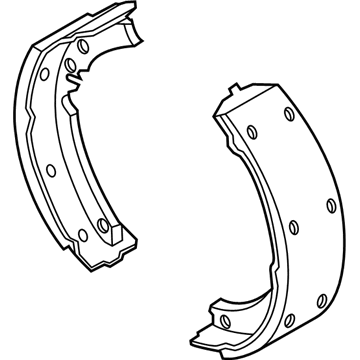
My Garage
My Account
Cart
Genuine Chevrolet Cruze Brake Shoe
Brake Shoe Set- Select Vehicle by Model
- Select Vehicle by VIN
Select Vehicle by Model
orMake
Model
Year
Select Vehicle by VIN
For the most accurate results, select vehicle by your VIN (Vehicle Identification Number).
1 Brake Shoe found
Chevrolet Cruze SHOE KIT-RR BRK
Part Number: 42794691$83.68 MSRP: $152.14You Save: $68.46 (45%)Ships in 1-2 Business Days
Chevrolet Cruze Brake Shoe
The Brake Shoe of Chevrolet Cruze are part of the drum brake system that produces enough friction to slow down the car. When the brakes are on the shoes make contact with the brake drum thereby developing friction and in the process the energy is transformed in form of heat. This mechanism is very necessary for the brake, especially for the rear wheel which normally contains the drum type of brakes. In the Chevrolet Cruze models, there can be several kinds of Brake Shoe such as non-servo style and duo-servo style. However, with regard to structure, duo-servo brakes self-energize and because of the design which permits the rotating drum to draw the shoe closer to it, the stopping power that this type of brake delivers is much greater. It is thus necessary to inspect and service the Brake Shoe often since contaminants and wear may lead to changes in the performance as well as increase safety risks.
Each OEM Chevrolet Cruze Brake Shoe we offer is competitively priced and comes with the assurance of the manufacturer's warranty for the part. Furthermore, we guarantee the speedy delivery of your orders right to your doorstep. Our hassle-free return policy is also in place for your peace of mind.
Chevrolet Cruze Brake Shoe Parts Questions & Experts Answers
- Q: How to replace the rear brake shoes on Chevrolet Cruze?A:Loosen the wheel lug nuts, raise the rear of the vehicle, and support it securely on jackstands while blocking the front wheels to prevent rolling. Release the parking brake and remove the wheel, ensuring that all four rear brake shoes are replaced simultaneously, but work on only one brake assembly at a time to avoid mixing parts. Follow the illustrations for the brake shoe replacement procedure, which includes removing the adjuster lever spring, disconnecting the upper return spring, and removing the shoes. Attach the upper return spring to the trailing shoe, install the shoes and hold-down springs, and clean and lube the adjuster threads before reinstalling the adjuster wheel. If the brake drum cannot be easily removed, ensure the parking brake is fully released and retract the brake shoes if necessary. Before reinstalling the drum, check for cracks and other damage; if any issues are found, take the drum to an automotive machine shop for resurfacing. Install the brake drum on the axle flange, pump the brake pedal, and adjust the star wheel until the shoes rub on the drum, then back off slightly. Install the wheel and lug nuts, lower the vehicle, and tighten the lug nuts to the specified torque. Make several forward and reverse stops and operate the parking brake to adjust the brakes for satisfactory pedal action, then carefully check the operation of the brakes before driving.








